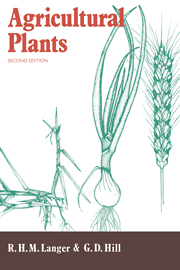Book contents
- Frontmatter
- Contents
- Preface to the first edition
- Preface to the second edition
- 1 World population and crop production
- 2 Plant structure
- 3 Liliaceae
- 4 Poaceae
- 5 Apiaceae
- 6 Asteraceae
- 7 Brassicaceae
- 8 Cannabinaceae
- 9 Chenopodiaceae
- 10 Cucurbitaceae
- 11 Fabaceae
- 12 Lamiaceae
- 13 Linaceae
- 14 Malvaceae
- 15 Papaveraceae
- 16 Solanaceae
- 17 Physiological basis of yield
- Index of specific names
- Subject index
Preface to the first edition
Published online by Cambridge University Press: 05 June 2012
- Frontmatter
- Contents
- Preface to the first edition
- Preface to the second edition
- 1 World population and crop production
- 2 Plant structure
- 3 Liliaceae
- 4 Poaceae
- 5 Apiaceae
- 6 Asteraceae
- 7 Brassicaceae
- 8 Cannabinaceae
- 9 Chenopodiaceae
- 10 Cucurbitaceae
- 11 Fabaceae
- 12 Lamiaceae
- 13 Linaceae
- 14 Malvaceae
- 15 Papaveraceae
- 16 Solanaceae
- 17 Physiological basis of yield
- Index of specific names
- Subject index
Summary
This book is intended to serve as an introduction to agricultural plants, their structure, botanical characteristics, their place in agriculture, their cultivation and uses. It is not a treatise on economic botany, nor does it cover details of farming practice. What we have attempted to do is to provide a description of important crop and pasture plants, illustrated wherever possible, as a basis for a foundation course in agricultural botany or plant science.
Although it was our plan originally to restrict ourselves to plants of the temperate zone, we soon realised that plant introduction and adaptation have helped to break down rigid geographic boundaries in many climatic regions. The emphasis on temperate species has been retained, but at the same time we have attempted to cover most of the important world crops at least in subtropical areas. On the other hand, we have concentrated on field crops to the exclusion of tree species. Another problem of definition facing us was the somewhat artificial division between agriculture and horticulture. Where the distinction is mainly one of scale of production, such as in many vegetable crops, we have included the species concerned, but for a treatment of fruit crops, flowers and herbs the student should refer to appropriate horticultural texts.
Taxonomic arguments have been avoided as being out of place in an introductory book of this kind. In arranging the families that we have included, we have adopted the simplistic approach of alphabetical order, except that we have placed the two representatives of the Monocotyledons at the beginning, to be followed by the Dicotyledons.
- Type
- Chapter
- Information
- Agricultural Plants , pp. xi - xiiPublisher: Cambridge University PressPrint publication year: 1991



